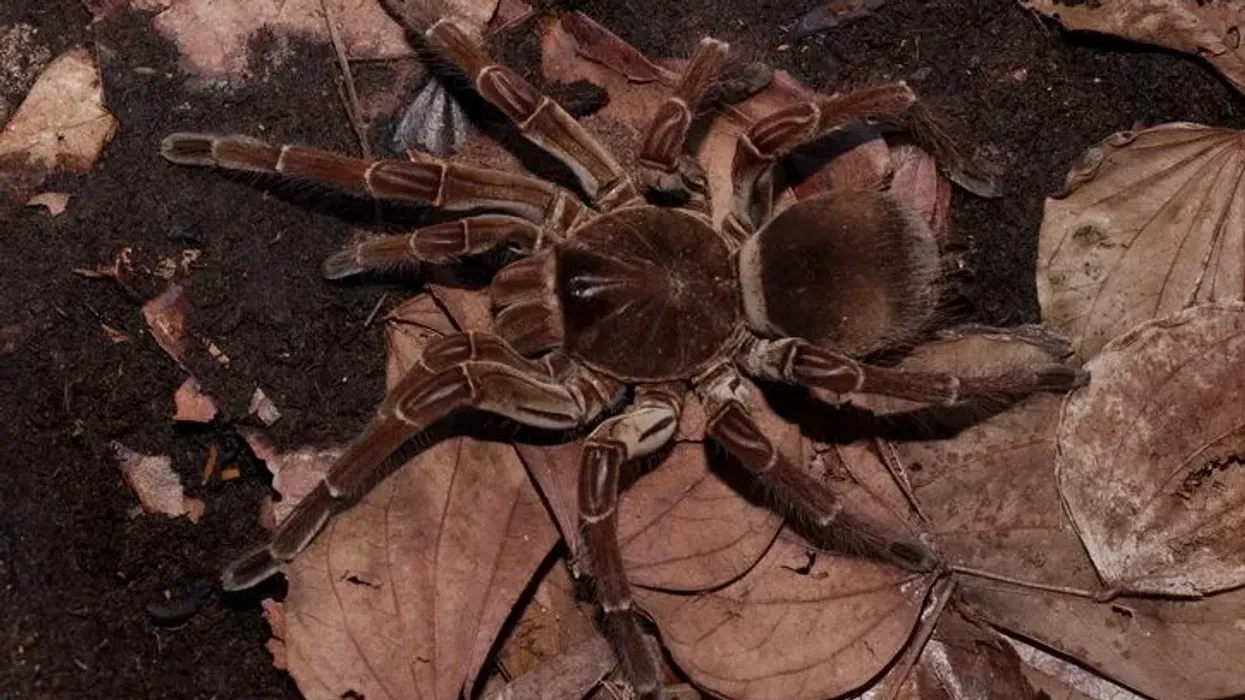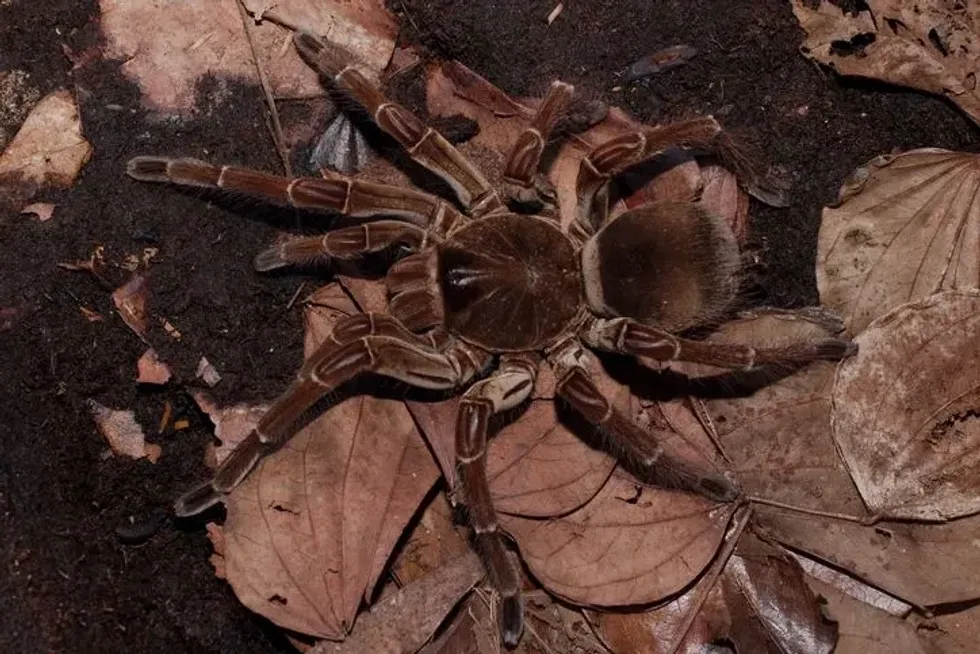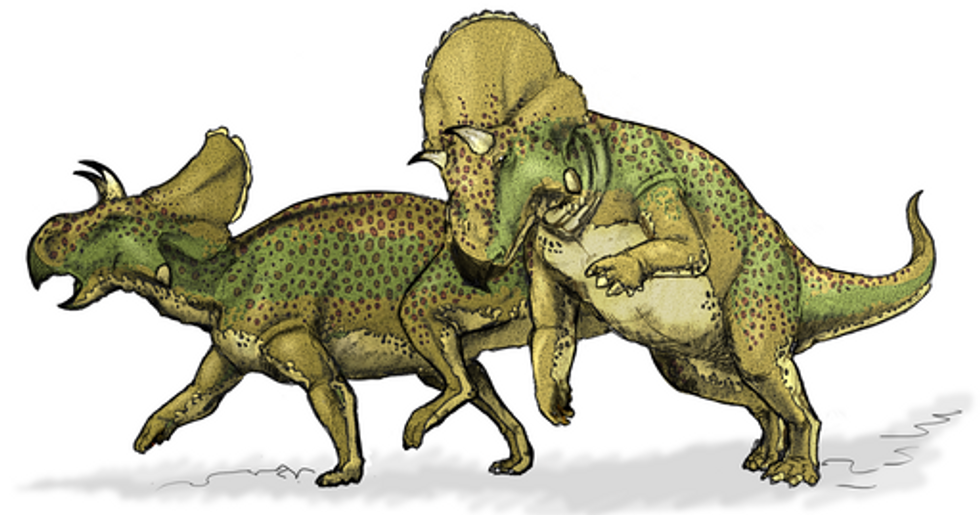The Goliath birdeater is the largest spider globally, found predominantly in South America. They are spread across Brazil, French Guyana, Suriname, and Venezuela. Their scientific name is Theraphosa Blondi. They belong to the class Arachnida, order Araneae family Theraphosidae and genus Theraphosa.
Ironical to their name, they are rarely found to be preying on birds. Their preys include large arthropods, rodents, worms, lizards, etc. The female species lives longer, with an average lifespan of 15 - 25 years.
They are light or dark brown or golden-hued in color. These tarantulas are nocturnal and opportunistic feeders. Their strong sense of touch compensates for their poor vision. They can sense their prey or predators by the urticating hair that picks up the slightest vibration from its surroundings.
The rubbing of their legs together creates a hissing to threaten any predator. The venom in these spiders' fangs is not fatal to humans. These goliath tarantulas are not bred but imported for pet markets.
If our article has piqued your curiosity for learning more fun stuff, please check our content on the Brazilian wandering spider and the grass spider.
Goliath Birdeater Interesting Facts
What type of animal is a Goliath birdeater?
The goliath birdeater is a spider species known to be the world's largest spider by mass and size. These exotic pets are not bred but are imported for the pet market worldwide.
What class of animal does a Goliath birdeater belong to?
The Goliath Bird Eating Spider belongs to the class Arachnida. The distinction of this class is mandibles, body parts for chewing and biting prey. They have a cephalothorax meaning fused head and thorax region.
How many Goliath birdeaters are there in the world?
There is no in-depth study on these goliath tarantulas' population count. They are a Not Evaluated categorized species by IUCN that needs more scientific intervention to understand where these animals stand. With this breed's rarity, we can assume that they are not populous.
Where does a Goliath birdeater live?
These goliath tarantulas are native to the Amazon rainforests in northern South America. The goliath birdeater location is spread from Brazil, Guyana, Suriname, and Venezuela.
What is a Goliath birdeater's habitat?
The goliath birdeater's habitat is spread amongst the rainforests' marshy wetland regions. They make their burrows under rocks or tree logs which provides them humidity for survival and they line their dwellings with their web.
Who do Goliath birdeaters live with?
The goliath bird-eating spider is a solitary creature and prefers to be left alone in its burrow. They are very aggressive and feel threatened quickly. It is difficult to rear two goliath tarantulas in the same cage. They are nocturnal animals and remain hidden in their burrows in the daytime.
How long does a Goliath birdeater live?
It is interesting to note that in these tarantula species, the female outlives the male. The female goliath birdeater lives for an average of 10 - 15 years and a maximum of 25 years in the wild. The male tarantulas live for three to six years only. The male of the species dies soon after their first successful mating.
How do they reproduce?
Reproduction happens between spring and early summer. The males approach the female's burrow and try to allure her for mating. There are special mating hooks on the males, which assist them in mating.
After mating, the female lays around 200 eggs in her burrow. The gestation period is six months for this species of spider. The spiderlings may be born in hundreds, but only a few of these animals make it to adulthood as they are preyed on by insects, frogs, and birds.
What is their conservation status?
As per the IUCN classification, goliath bird-eating spiders are in the Not Evaluated category. Though they are widely distributed in their habitats, threats to their existence cannot be ruled out. Increasing demand in the pet trade, loss of habitat, and human intervention are severe threats to these animals.
Goliath Birdeater Fun Facts
What do Goliath birdeaters look like?

The South American goliath birdeater is a bulky creature with a large abdomen and smaller cephalothorax. The spinnerets are situated at the end of the abdomen. Their inch and a half long fangs are based in front of the cephalothorax. The fangs have venom in them. The Birdeater Goliath lacks the tibial spur like the other tarantula species.
Their exoskeleton is shielded by dark or light brown hair in color. The Goliath Birdeaters have eight legs and eight eyes.
They have short limb-like structures on either side of their head called pedipalps that help them hold onto the prey. Although there is no clear data on goliath birdeater changing color as it ages, a closer species called Antilles pinktoe changes color as they age. Their abdomen becomes blue, pink, or red, and carapace turns metallic green.
How cute are they?
Their mammoth size and swiftness would fascinate any arachnid lover. Their hissing is sure to keep you amused. The coffee color body covered in series of hairs is another desirable feature making them score big in the cuteness division.
How do they communicate?
When frightened, The Goliath Birdeater tarantula makes a hissing sound by rubbing their legs together. This process of rubbing body parts together to generate vibrations is called Stridulation. This superior sound is to scare away its predators. The hissing noise gets carried up to 15 feet away. Stridulation is an inherent characteristic of arthropods.
Another defense mechanism in these tarantulas is releasing the urticating hairs from their abdomen to attack their attackers. When launched on predators, these tiny urticating hairs can harm their eyes, nose, and mouth, temporarily disabling them.
How big is a Goliath birdeater?
The goliath birdeater tarantula is the largest spider in the world regarding body mass and body size. It has a leg span reaching 11.5 inches (28 cm). Giant huntsman spider vs. goliath birdeater size tells us that only the giant huntsman spider surpasses the leg span of the goliath birdeater by reaching 30 cm.
How fast can a Goliath birdeater run?
As these spider species are solitary, they need to fend and provide for themselves. To protect themselves, they need to be fast and quick on their feet. They are always up on their guard and have many defense mechanisms to protect themselves.
How much does a Goliath birdeater weigh?
The goliath birdeater weighs around 6 oz and is the largest spider by mass. The jumping spider is way lighter than these mammoth spiders as they weigh only 0.0004 oz.
What are their male and female names of the species?
There is no specific name for a male and female spider. They are referred to as Males or females. The females are larger than their male counterparts and live longer too.
What would you call a baby Goliath birdeater?
Spiderling is the name given to the baby spider. The first molt of the spiderling makes it independent from the nest. The spiderlings reach sexual maturity at the age of two to three years.
What do they eat?
The goliath bird-eating spiders prey on large arthropods, worms, lizards, insects, etc. Contrary to their name suggesting that they eat birds, they rarely eat birds.
These tarantulas' venom kills and breaks down the prey into digestible juices. These spiders are preyed on by tarantula hawks, some snakes, or other giant tarantulas. Freshly molted tarantulas are vulnerable to attacks from smaller insects.
Are they poisonous?
Though the goliath birdeater is poisonous or venomous, their venom does not cause much harm to humans. Goliath birdeater fangs contain venom. The tarantula bite will not kill humans. The venom from the goliath birdeater bite will sting like a wasp bite. These spiders are primarily docile, and they only attack humans if they feel intimidated.
Would they make a good pet?
The goliath bird-eating spiders are exotic pets. It is not a pet for beginners as they are challenging to deal with. Their care requires large enclosures and high maintenance arrangements. Their defense mechanisms with their abdomen's tiny hairs are also an irritant factor to look after.
The cleaning process after the molting is another challenge to account for. The goliath birdeaters make good pets for people who are really into them. Their price can range anywhere between $10 to $500 depending on the species' age and rarity.
Did you know...
The goliath birdeater tarantula can revive its lost limbs by molting. After the molt or shedding of old body parts, new body parts are regenerated.
The goliath birdeater tarantula female creates a web around the eggs laid by her, makes it into a ball, and moves around. This is one of the features unique to this tarantula species.
In the March of 2017, three new goliath birdeaters were discovered in Peru, Ecuador, and Brazil.
The goliath birdeater tarantula has very poor eyesight, unlike the Jumping spider, which boasts a good vision.
What are a Goliath birdeater's hairs used for?
The tiny harpoon-like hair or the urticating hairs on the Goliath Bird Eating spiders' exoskeleton help them protect themselves from predators. In a defense mechanism unique to them, they shoot these tiny hairs on their predators and keep them away.
These tiny hairs also produce a hissing sound when the goliath birdeater rubs its legs to ward off any threats. The tarantula hair is removed, and the animal is roasted to be served as a South American delicacy.
Do Goliath birdeaters spin webs?
Unlike other tarantula species, these giant spiders do not spin webs to trap their prey. The goliath birdeater web is used for lining the burrow in the forest floor. The females also use the webs to protect their eggs.
Here at Kidadl, we have carefully created lots of interesting family-friendly animal facts for everyone to discover! Learn more about some other arthropods, including the orb-weaver spider and the yellow sac spider.
You can even occupy yourself at home by drawing one of our goliath birdeater coloring pages.









